A Report on Hidden Impacts of Diabetes on Health and Social Care
VerifiedAdded on 2024/06/11
|13
|3010
|408
Report
AI Summary
This research report explores the hidden impacts of diabetes on health and social care, focusing on the UK. It begins by establishing a rationale for the study, highlighting the increasing prevalence of diabetes and its burden on the NHS. The report outlines specific aims and objectives, including enhancing the living standards of people with diabetes, raising awareness, and addressing stigma. A literature review summarizes existing research on diabetes prevalence, costs, and prevention programs. The report details the causes and symptoms of diabetes, as well as measures for prevention, such as diet and exercise. The research methodology employs both primary (surveys) and secondary research methods, with a random sampling technique. An action plan outlines the timeline for data collection, evaluation, and conclusion. Finally, the report acknowledges limitations such as time constraints and sample size. This document provides a comprehensive overview of diabetes' hidden impacts and potential strategies for mitigation.
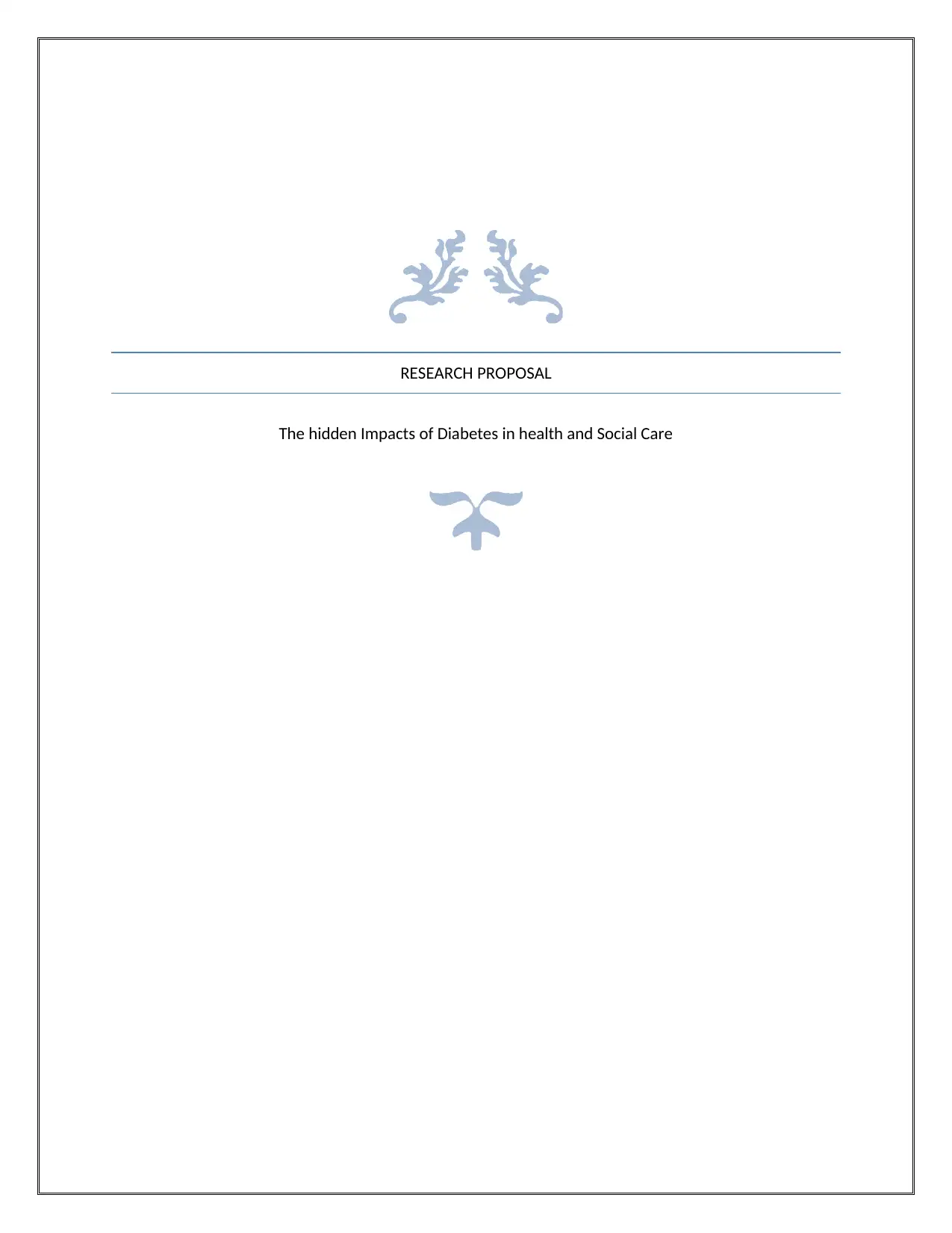
RESEARCH PROPOSAL
The hidden Impacts of Diabetes in health and Social Care
The hidden Impacts of Diabetes in health and Social Care
Paraphrase This Document
Need a fresh take? Get an instant paraphrase of this document with our AI Paraphraser
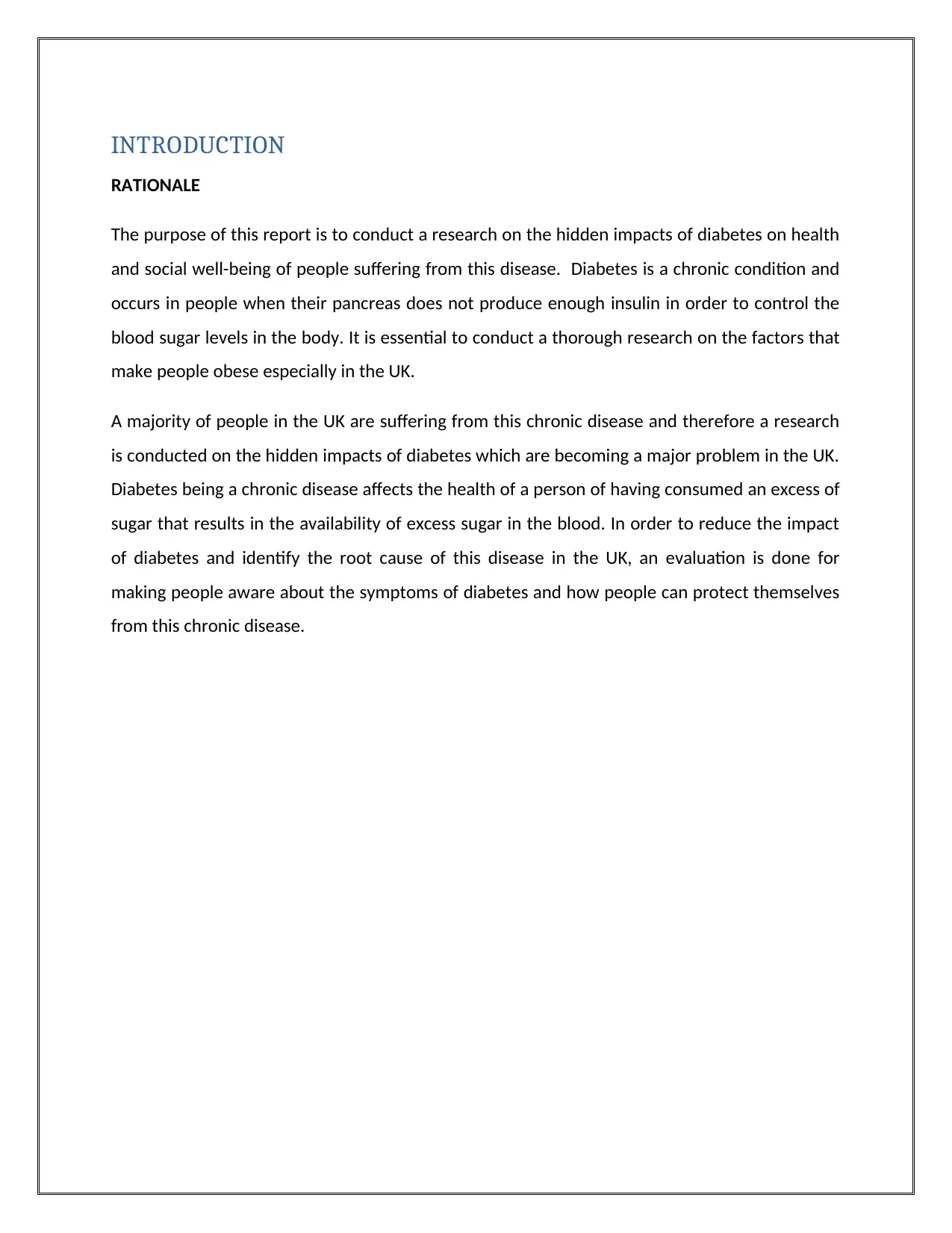
INTRODUCTION
RATIONALE
The purpose of this report is to conduct a research on the hidden impacts of diabetes on health
and social well-being of people suffering from this disease. Diabetes is a chronic condition and
occurs in people when their pancreas does not produce enough insulin in order to control the
blood sugar levels in the body. It is essential to conduct a thorough research on the factors that
make people obese especially in the UK.
A majority of people in the UK are suffering from this chronic disease and therefore a research
is conducted on the hidden impacts of diabetes which are becoming a major problem in the UK.
Diabetes being a chronic disease affects the health of a person of having consumed an excess of
sugar that results in the availability of excess sugar in the blood. In order to reduce the impact
of diabetes and identify the root cause of this disease in the UK, an evaluation is done for
making people aware about the symptoms of diabetes and how people can protect themselves
from this chronic disease.
RATIONALE
The purpose of this report is to conduct a research on the hidden impacts of diabetes on health
and social well-being of people suffering from this disease. Diabetes is a chronic condition and
occurs in people when their pancreas does not produce enough insulin in order to control the
blood sugar levels in the body. It is essential to conduct a thorough research on the factors that
make people obese especially in the UK.
A majority of people in the UK are suffering from this chronic disease and therefore a research
is conducted on the hidden impacts of diabetes which are becoming a major problem in the UK.
Diabetes being a chronic disease affects the health of a person of having consumed an excess of
sugar that results in the availability of excess sugar in the blood. In order to reduce the impact
of diabetes and identify the root cause of this disease in the UK, an evaluation is done for
making people aware about the symptoms of diabetes and how people can protect themselves
from this chronic disease.
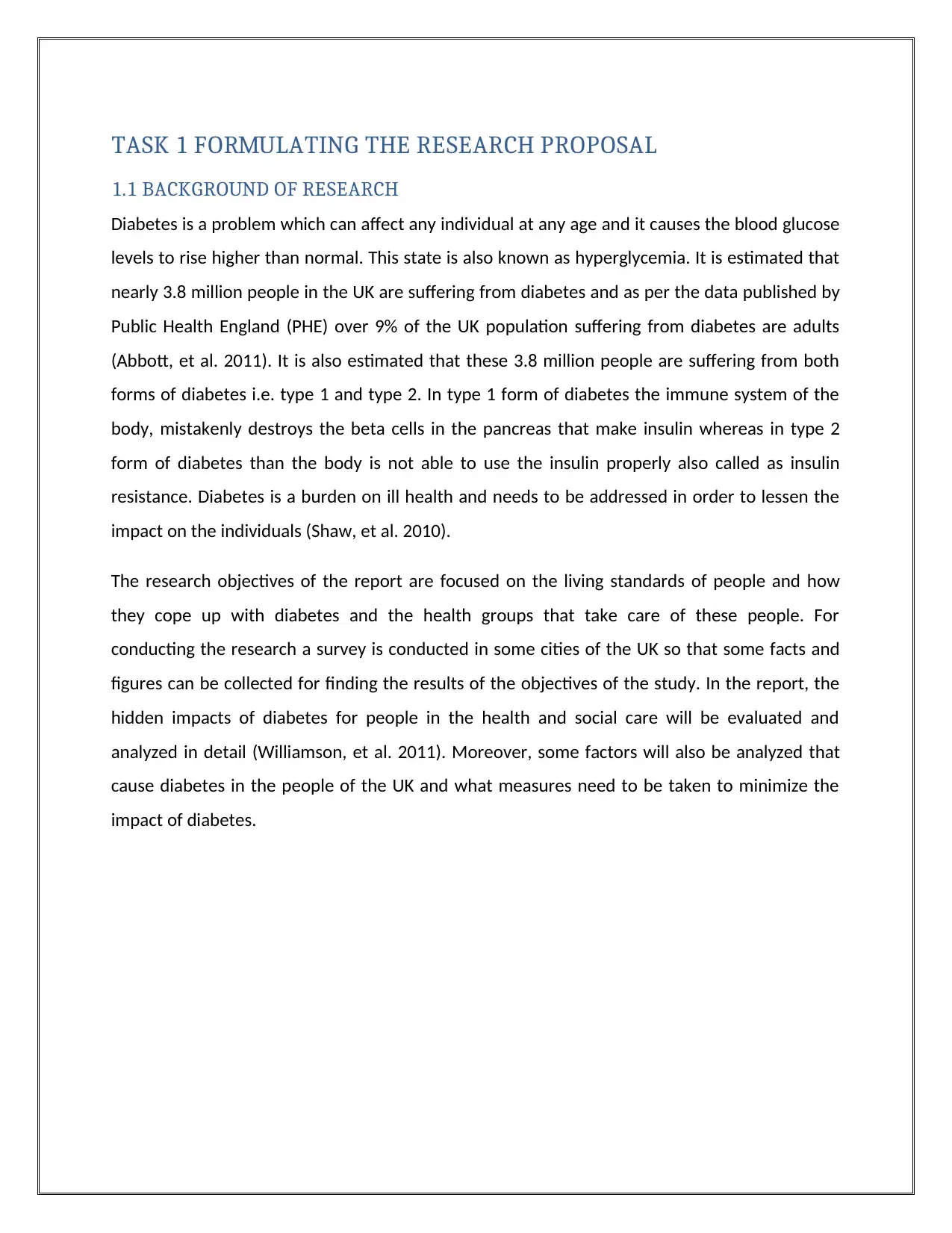
TASK 1 FORMULATING THE RESEARCH PROPOSAL
1.1 BACKGROUND OF RESEARCH
Diabetes is a problem which can affect any individual at any age and it causes the blood glucose
levels to rise higher than normal. This state is also known as hyperglycemia. It is estimated that
nearly 3.8 million people in the UK are suffering from diabetes and as per the data published by
Public Health England (PHE) over 9% of the UK population suffering from diabetes are adults
(Abbott, et al. 2011). It is also estimated that these 3.8 million people are suffering from both
forms of diabetes i.e. type 1 and type 2. In type 1 form of diabetes the immune system of the
body, mistakenly destroys the beta cells in the pancreas that make insulin whereas in type 2
form of diabetes than the body is not able to use the insulin properly also called as insulin
resistance. Diabetes is a burden on ill health and needs to be addressed in order to lessen the
impact on the individuals (Shaw, et al. 2010).
The research objectives of the report are focused on the living standards of people and how
they cope up with diabetes and the health groups that take care of these people. For
conducting the research a survey is conducted in some cities of the UK so that some facts and
figures can be collected for finding the results of the objectives of the study. In the report, the
hidden impacts of diabetes for people in the health and social care will be evaluated and
analyzed in detail (Williamson, et al. 2011). Moreover, some factors will also be analyzed that
cause diabetes in the people of the UK and what measures need to be taken to minimize the
impact of diabetes.
1.1 BACKGROUND OF RESEARCH
Diabetes is a problem which can affect any individual at any age and it causes the blood glucose
levels to rise higher than normal. This state is also known as hyperglycemia. It is estimated that
nearly 3.8 million people in the UK are suffering from diabetes and as per the data published by
Public Health England (PHE) over 9% of the UK population suffering from diabetes are adults
(Abbott, et al. 2011). It is also estimated that these 3.8 million people are suffering from both
forms of diabetes i.e. type 1 and type 2. In type 1 form of diabetes the immune system of the
body, mistakenly destroys the beta cells in the pancreas that make insulin whereas in type 2
form of diabetes than the body is not able to use the insulin properly also called as insulin
resistance. Diabetes is a burden on ill health and needs to be addressed in order to lessen the
impact on the individuals (Shaw, et al. 2010).
The research objectives of the report are focused on the living standards of people and how
they cope up with diabetes and the health groups that take care of these people. For
conducting the research a survey is conducted in some cities of the UK so that some facts and
figures can be collected for finding the results of the objectives of the study. In the report, the
hidden impacts of diabetes for people in the health and social care will be evaluated and
analyzed in detail (Williamson, et al. 2011). Moreover, some factors will also be analyzed that
cause diabetes in the people of the UK and what measures need to be taken to minimize the
impact of diabetes.
⊘ This is a preview!⊘
Do you want full access?
Subscribe today to unlock all pages.

Trusted by 1+ million students worldwide
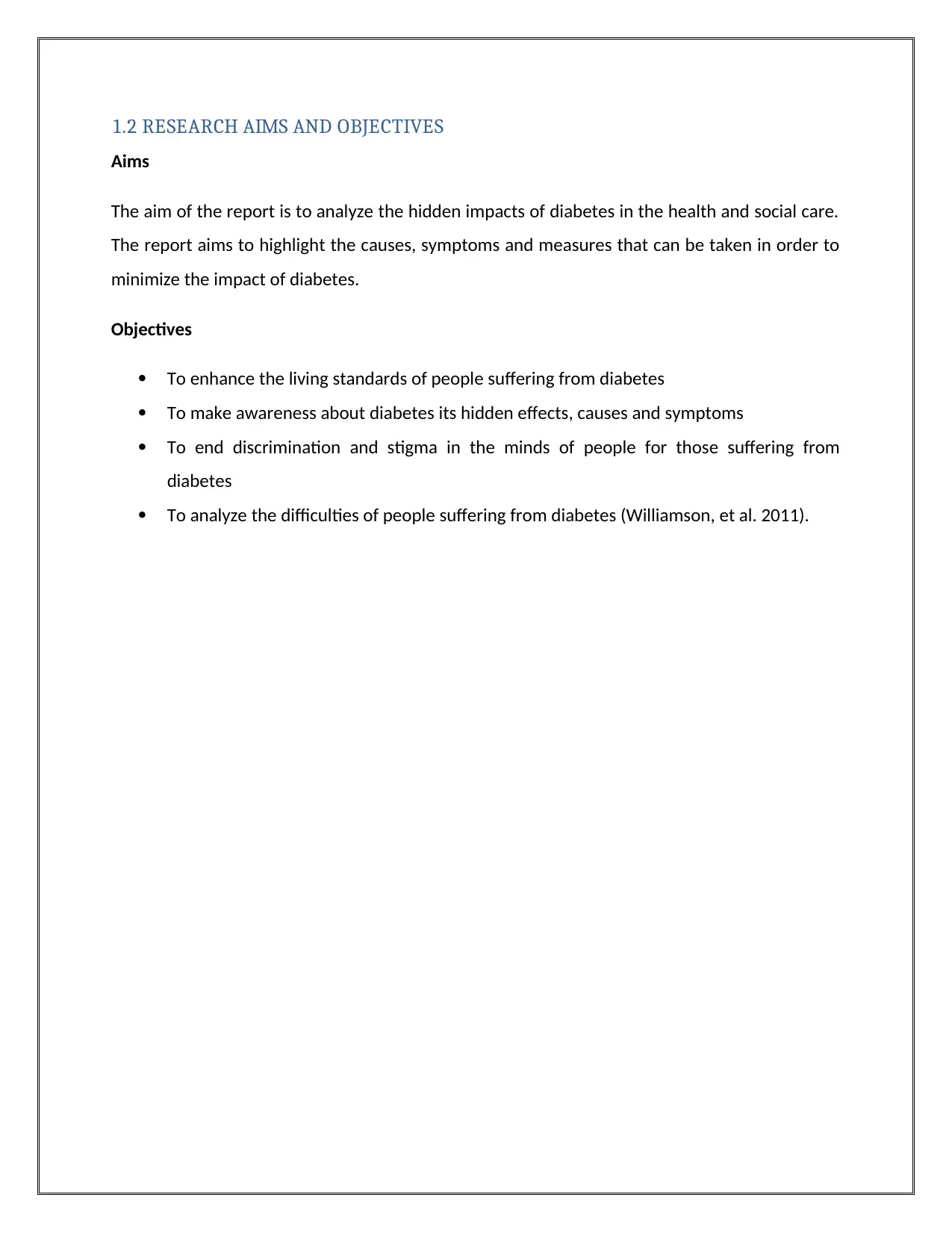
1.2 RESEARCH AIMS AND OBJECTIVES
Aims
The aim of the report is to analyze the hidden impacts of diabetes in the health and social care.
The report aims to highlight the causes, symptoms and measures that can be taken in order to
minimize the impact of diabetes.
Objectives
To enhance the living standards of people suffering from diabetes
To make awareness about diabetes its hidden effects, causes and symptoms
To end discrimination and stigma in the minds of people for those suffering from
diabetes
To analyze the difficulties of people suffering from diabetes (Williamson, et al. 2011).
Aims
The aim of the report is to analyze the hidden impacts of diabetes in the health and social care.
The report aims to highlight the causes, symptoms and measures that can be taken in order to
minimize the impact of diabetes.
Objectives
To enhance the living standards of people suffering from diabetes
To make awareness about diabetes its hidden effects, causes and symptoms
To end discrimination and stigma in the minds of people for those suffering from
diabetes
To analyze the difficulties of people suffering from diabetes (Williamson, et al. 2011).
Paraphrase This Document
Need a fresh take? Get an instant paraphrase of this document with our AI Paraphraser

1.3 LITERATURE REVIEW
As per the research conducted by Dyson, et al. 2011 in their report stated that the number of
people suffering from diabetes is increasing steadily and it is highly important for the NHS to
tackle this situation for ensuring the sustainable future of the NHS. It is estimated that diabetes
costs NHS approximately £10 billion a year in handling people suffering from diabetes. Diabetes
refers to a condition in which the amount of sugar in the blood increases to a high level than
normal. The type one form of diabetes develops in the body if the body is unable to produce
any insulin whereas type 2 form of diabetes gets developed when the body cells do not react to
the insulin.
Hex, et al. 2012 stated in their report that the proportion of people suffering from diabetes is
increasing and 9 % of the people in the age group of 45 to 54 are suffering from diabetes. Older
people having diabetes have more severe implications than people of younger generations.
They also stated that diabetes is more common in men In comparison to women and people
from African and black ethnic groups are more likely to suffer from diabetes than people from
white and mixed ethnic groups.
(Rayman and Kilvert, 2012) stated that based on the current population trends approximately
4.8 million people will have diabetes by the end of the year 2035. The second form of diabetes
called as type 2 costs NHS approximately £8.9 million every year and it is essential for the
healthcare organizations like the NHS to tackle with this situation for the sustainable future of
the health service. For tacking to this situations healthcare organizations have also launched
many diabetes prevention programs, for example, NHS DPP, Diabetes UK etc. These programs
and events are likely to raise awareness for reducing the effects of diabetes or developing the
condition of diabetes. These Programs guide people as to what diet plan needs to be followed
and how to reduce the weight as a preventive measure to fight against diabetes.
Scarborough, et al. 2011 stated that it is essentially important for people suffering from
diabetes to follow a strict diet plan which is healthy and develop a habit of playing any sport
that has physical activity. NHS has launched an activity program in which various form of
exercises is taught to the people suffering from diabetes for improving their health. The NHS
As per the research conducted by Dyson, et al. 2011 in their report stated that the number of
people suffering from diabetes is increasing steadily and it is highly important for the NHS to
tackle this situation for ensuring the sustainable future of the NHS. It is estimated that diabetes
costs NHS approximately £10 billion a year in handling people suffering from diabetes. Diabetes
refers to a condition in which the amount of sugar in the blood increases to a high level than
normal. The type one form of diabetes develops in the body if the body is unable to produce
any insulin whereas type 2 form of diabetes gets developed when the body cells do not react to
the insulin.
Hex, et al. 2012 stated in their report that the proportion of people suffering from diabetes is
increasing and 9 % of the people in the age group of 45 to 54 are suffering from diabetes. Older
people having diabetes have more severe implications than people of younger generations.
They also stated that diabetes is more common in men In comparison to women and people
from African and black ethnic groups are more likely to suffer from diabetes than people from
white and mixed ethnic groups.
(Rayman and Kilvert, 2012) stated that based on the current population trends approximately
4.8 million people will have diabetes by the end of the year 2035. The second form of diabetes
called as type 2 costs NHS approximately £8.9 million every year and it is essential for the
healthcare organizations like the NHS to tackle with this situation for the sustainable future of
the health service. For tacking to this situations healthcare organizations have also launched
many diabetes prevention programs, for example, NHS DPP, Diabetes UK etc. These programs
and events are likely to raise awareness for reducing the effects of diabetes or developing the
condition of diabetes. These Programs guide people as to what diet plan needs to be followed
and how to reduce the weight as a preventive measure to fight against diabetes.
Scarborough, et al. 2011 stated that it is essentially important for people suffering from
diabetes to follow a strict diet plan which is healthy and develop a habit of playing any sport
that has physical activity. NHS has launched an activity program in which various form of
exercises is taught to the people suffering from diabetes for improving their health. The NHS
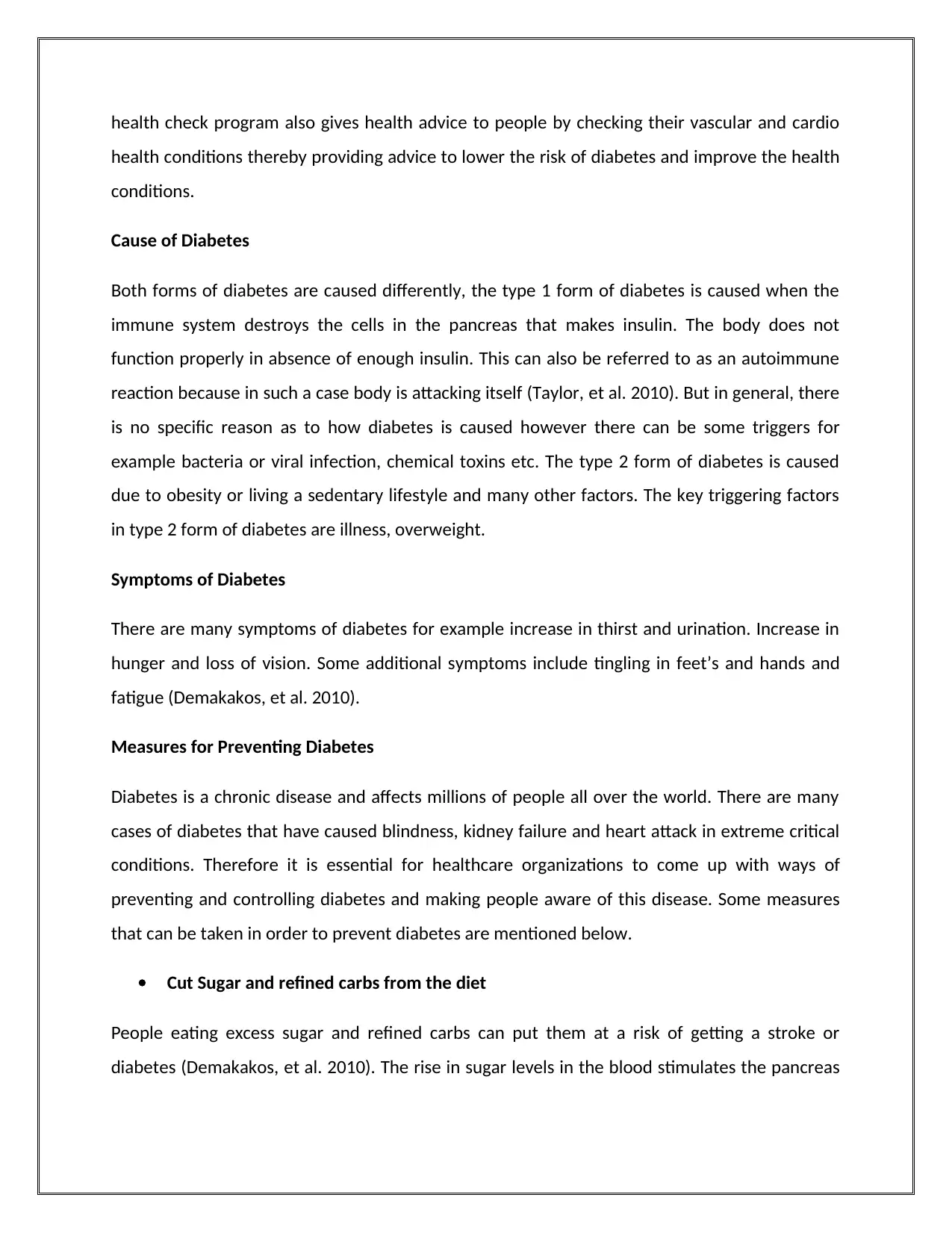
health check program also gives health advice to people by checking their vascular and cardio
health conditions thereby providing advice to lower the risk of diabetes and improve the health
conditions.
Cause of Diabetes
Both forms of diabetes are caused differently, the type 1 form of diabetes is caused when the
immune system destroys the cells in the pancreas that makes insulin. The body does not
function properly in absence of enough insulin. This can also be referred to as an autoimmune
reaction because in such a case body is attacking itself (Taylor, et al. 2010). But in general, there
is no specific reason as to how diabetes is caused however there can be some triggers for
example bacteria or viral infection, chemical toxins etc. The type 2 form of diabetes is caused
due to obesity or living a sedentary lifestyle and many other factors. The key triggering factors
in type 2 form of diabetes are illness, overweight.
Symptoms of Diabetes
There are many symptoms of diabetes for example increase in thirst and urination. Increase in
hunger and loss of vision. Some additional symptoms include tingling in feet’s and hands and
fatigue (Demakakos, et al. 2010).
Measures for Preventing Diabetes
Diabetes is a chronic disease and affects millions of people all over the world. There are many
cases of diabetes that have caused blindness, kidney failure and heart attack in extreme critical
conditions. Therefore it is essential for healthcare organizations to come up with ways of
preventing and controlling diabetes and making people aware of this disease. Some measures
that can be taken in order to prevent diabetes are mentioned below.
Cut Sugar and refined carbs from the diet
People eating excess sugar and refined carbs can put them at a risk of getting a stroke or
diabetes (Demakakos, et al. 2010). The rise in sugar levels in the blood stimulates the pancreas
health conditions thereby providing advice to lower the risk of diabetes and improve the health
conditions.
Cause of Diabetes
Both forms of diabetes are caused differently, the type 1 form of diabetes is caused when the
immune system destroys the cells in the pancreas that makes insulin. The body does not
function properly in absence of enough insulin. This can also be referred to as an autoimmune
reaction because in such a case body is attacking itself (Taylor, et al. 2010). But in general, there
is no specific reason as to how diabetes is caused however there can be some triggers for
example bacteria or viral infection, chemical toxins etc. The type 2 form of diabetes is caused
due to obesity or living a sedentary lifestyle and many other factors. The key triggering factors
in type 2 form of diabetes are illness, overweight.
Symptoms of Diabetes
There are many symptoms of diabetes for example increase in thirst and urination. Increase in
hunger and loss of vision. Some additional symptoms include tingling in feet’s and hands and
fatigue (Demakakos, et al. 2010).
Measures for Preventing Diabetes
Diabetes is a chronic disease and affects millions of people all over the world. There are many
cases of diabetes that have caused blindness, kidney failure and heart attack in extreme critical
conditions. Therefore it is essential for healthcare organizations to come up with ways of
preventing and controlling diabetes and making people aware of this disease. Some measures
that can be taken in order to prevent diabetes are mentioned below.
Cut Sugar and refined carbs from the diet
People eating excess sugar and refined carbs can put them at a risk of getting a stroke or
diabetes (Demakakos, et al. 2010). The rise in sugar levels in the blood stimulates the pancreas
⊘ This is a preview!⊘
Do you want full access?
Subscribe today to unlock all pages.

Trusted by 1+ million students worldwide
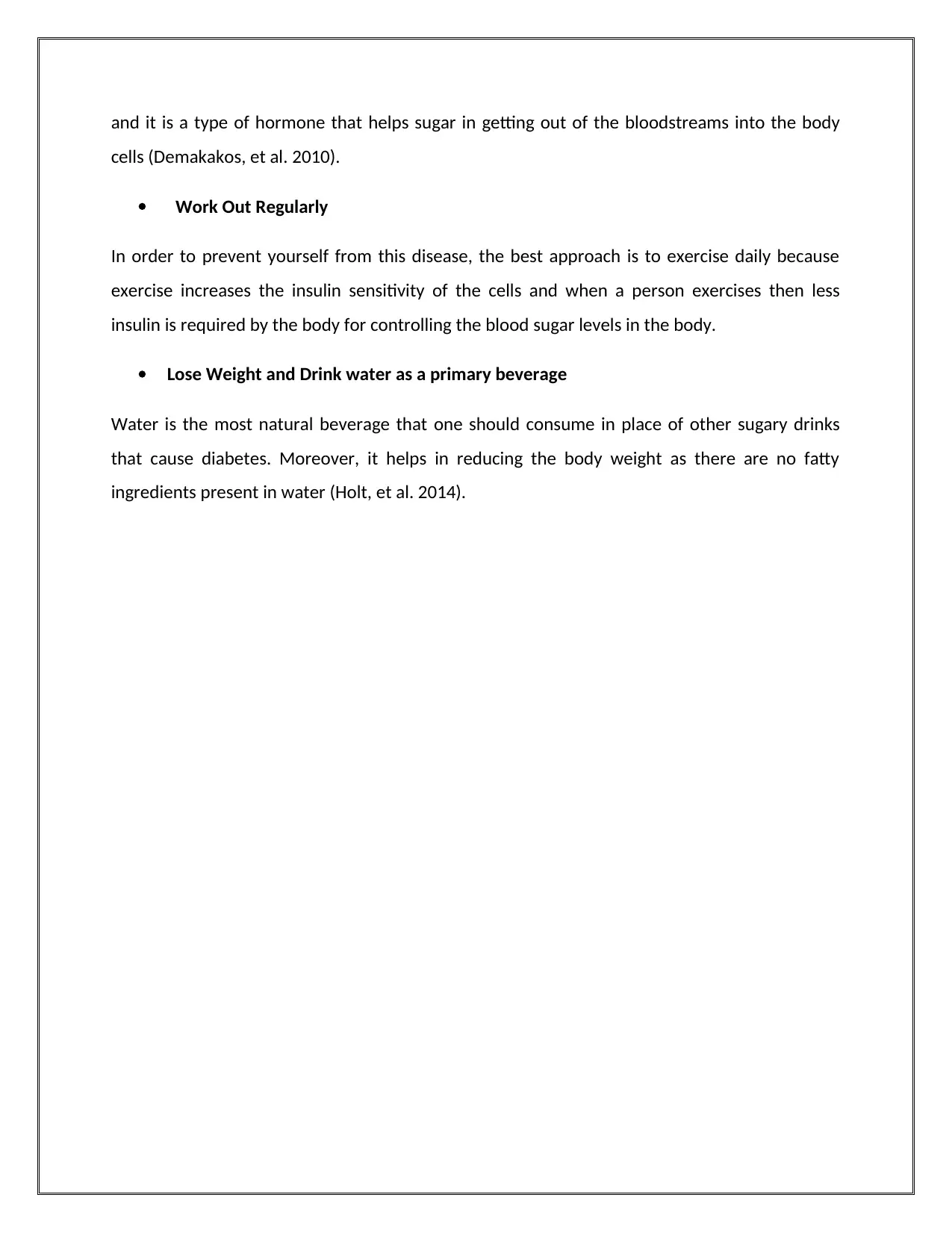
and it is a type of hormone that helps sugar in getting out of the bloodstreams into the body
cells (Demakakos, et al. 2010).
Work Out Regularly
In order to prevent yourself from this disease, the best approach is to exercise daily because
exercise increases the insulin sensitivity of the cells and when a person exercises then less
insulin is required by the body for controlling the blood sugar levels in the body.
Lose Weight and Drink water as a primary beverage
Water is the most natural beverage that one should consume in place of other sugary drinks
that cause diabetes. Moreover, it helps in reducing the body weight as there are no fatty
ingredients present in water (Holt, et al. 2014).
cells (Demakakos, et al. 2010).
Work Out Regularly
In order to prevent yourself from this disease, the best approach is to exercise daily because
exercise increases the insulin sensitivity of the cells and when a person exercises then less
insulin is required by the body for controlling the blood sugar levels in the body.
Lose Weight and Drink water as a primary beverage
Water is the most natural beverage that one should consume in place of other sugary drinks
that cause diabetes. Moreover, it helps in reducing the body weight as there are no fatty
ingredients present in water (Holt, et al. 2014).
Paraphrase This Document
Need a fresh take? Get an instant paraphrase of this document with our AI Paraphraser

1.4 RESEARCH METHODOLOGY
The research methodology discusses the various kinds of techniques that will be used in order
to collect the information for finding the aims and objectives of the study. There are two forms
of techniques that will be used for conducting the research one is the primary research and the
other is the secondary research (Smith, 2015). The primary research is conducted in order to
specific needs of the project. It is conducted for getting the qualitative data that is highly
accurate and reliable. In this form of research, the researcher goes directly to the source for
collecting the data for example customers or target market. Some examples of primary research
are interviews, surveys, focus groups etc. In this report, the survey will be conducted as a
primary research method. The secondary research is a form of research that can be gathered,
compiled and published by others. Through secondary research quantitative data is collected
which is less accurate in comparison to qualitative data. Some examples of secondary research
methods are literature reviews, government websites, and agencies etc. (Cheng and Phillips,
2014).
For conducting the primary research random sampling technique will be used as it gives
everyone an equal opportunity to become a part of the survey conducted by the researchers.
The sampling size would be 50 persons suffering from diabetes and questions will be asked on
various topics related to diabetes in relation to the aims and objectives of the study (Cheng and
Phillips, 2014). The data collected from the respondents will then be interpreted and analyzed
for finding the objectives of the study.
The research methodology discusses the various kinds of techniques that will be used in order
to collect the information for finding the aims and objectives of the study. There are two forms
of techniques that will be used for conducting the research one is the primary research and the
other is the secondary research (Smith, 2015). The primary research is conducted in order to
specific needs of the project. It is conducted for getting the qualitative data that is highly
accurate and reliable. In this form of research, the researcher goes directly to the source for
collecting the data for example customers or target market. Some examples of primary research
are interviews, surveys, focus groups etc. In this report, the survey will be conducted as a
primary research method. The secondary research is a form of research that can be gathered,
compiled and published by others. Through secondary research quantitative data is collected
which is less accurate in comparison to qualitative data. Some examples of secondary research
methods are literature reviews, government websites, and agencies etc. (Cheng and Phillips,
2014).
For conducting the primary research random sampling technique will be used as it gives
everyone an equal opportunity to become a part of the survey conducted by the researchers.
The sampling size would be 50 persons suffering from diabetes and questions will be asked on
various topics related to diabetes in relation to the aims and objectives of the study (Cheng and
Phillips, 2014). The data collected from the respondents will then be interpreted and analyzed
for finding the objectives of the study.
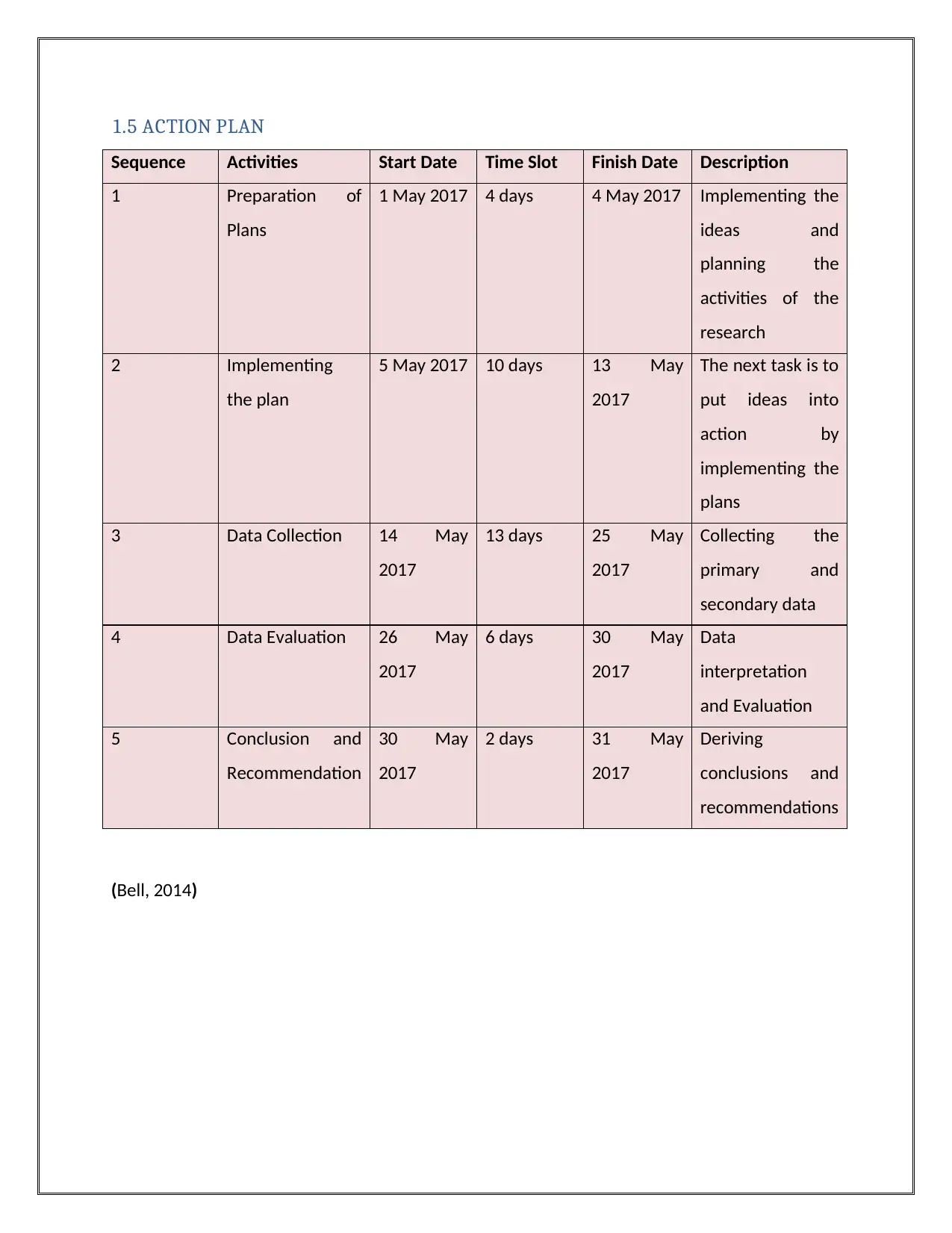
1.5 ACTION PLAN
Sequence Activities Start Date Time Slot Finish Date Description
1 Preparation of
Plans
1 May 2017 4 days 4 May 2017 Implementing the
ideas and
planning the
activities of the
research
2 Implementing
the plan
5 May 2017 10 days 13 May
2017
The next task is to
put ideas into
action by
implementing the
plans
3 Data Collection 14 May
2017
13 days 25 May
2017
Collecting the
primary and
secondary data
4 Data Evaluation 26 May
2017
6 days 30 May
2017
Data
interpretation
and Evaluation
5 Conclusion and
Recommendation
30 May
2017
2 days 31 May
2017
Deriving
conclusions and
recommendations
(Bell, 2014)
Sequence Activities Start Date Time Slot Finish Date Description
1 Preparation of
Plans
1 May 2017 4 days 4 May 2017 Implementing the
ideas and
planning the
activities of the
research
2 Implementing
the plan
5 May 2017 10 days 13 May
2017
The next task is to
put ideas into
action by
implementing the
plans
3 Data Collection 14 May
2017
13 days 25 May
2017
Collecting the
primary and
secondary data
4 Data Evaluation 26 May
2017
6 days 30 May
2017
Data
interpretation
and Evaluation
5 Conclusion and
Recommendation
30 May
2017
2 days 31 May
2017
Deriving
conclusions and
recommendations
(Bell, 2014)
⊘ This is a preview!⊘
Do you want full access?
Subscribe today to unlock all pages.

Trusted by 1+ million students worldwide
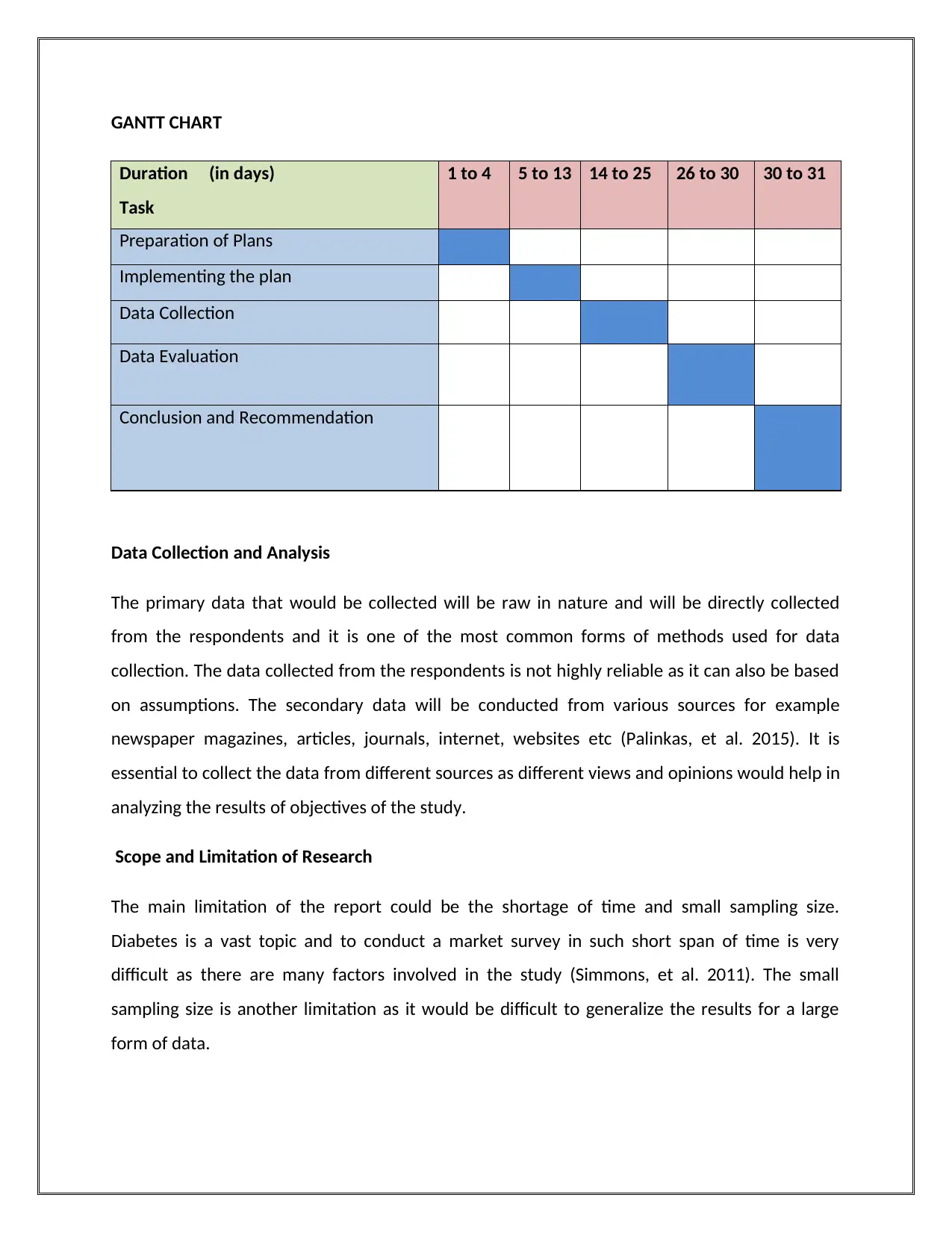
GANTT CHART
Duration (in days)
Task
1 to 4 5 to 13 14 to 25 26 to 30 30 to 31
Preparation of Plans
Implementing the plan
Data Collection
Data Evaluation
Conclusion and Recommendation
Data Collection and Analysis
The primary data that would be collected will be raw in nature and will be directly collected
from the respondents and it is one of the most common forms of methods used for data
collection. The data collected from the respondents is not highly reliable as it can also be based
on assumptions. The secondary data will be conducted from various sources for example
newspaper magazines, articles, journals, internet, websites etc (Palinkas, et al. 2015). It is
essential to collect the data from different sources as different views and opinions would help in
analyzing the results of objectives of the study.
Scope and Limitation of Research
The main limitation of the report could be the shortage of time and small sampling size.
Diabetes is a vast topic and to conduct a market survey in such short span of time is very
difficult as there are many factors involved in the study (Simmons, et al. 2011). The small
sampling size is another limitation as it would be difficult to generalize the results for a large
form of data.
Duration (in days)
Task
1 to 4 5 to 13 14 to 25 26 to 30 30 to 31
Preparation of Plans
Implementing the plan
Data Collection
Data Evaluation
Conclusion and Recommendation
Data Collection and Analysis
The primary data that would be collected will be raw in nature and will be directly collected
from the respondents and it is one of the most common forms of methods used for data
collection. The data collected from the respondents is not highly reliable as it can also be based
on assumptions. The secondary data will be conducted from various sources for example
newspaper magazines, articles, journals, internet, websites etc (Palinkas, et al. 2015). It is
essential to collect the data from different sources as different views and opinions would help in
analyzing the results of objectives of the study.
Scope and Limitation of Research
The main limitation of the report could be the shortage of time and small sampling size.
Diabetes is a vast topic and to conduct a market survey in such short span of time is very
difficult as there are many factors involved in the study (Simmons, et al. 2011). The small
sampling size is another limitation as it would be difficult to generalize the results for a large
form of data.
Paraphrase This Document
Need a fresh take? Get an instant paraphrase of this document with our AI Paraphraser

Ethical Considerations
Some ethical considerations for executing the project activity were considered while collecting
the data or information from the respondents. It was ensured that respondent’s private
information is kept confidential so that it does not affect their personal or professional life. The
data used is protected and is used for the sole purpose of finding the objectives of the research
conducted (Simmons, et al. 2011).
Some ethical considerations for executing the project activity were considered while collecting
the data or information from the respondents. It was ensured that respondent’s private
information is kept confidential so that it does not affect their personal or professional life. The
data used is protected and is used for the sole purpose of finding the objectives of the research
conducted (Simmons, et al. 2011).

REFERENCES
1 Abbott, C.A., Malik, R.A., Ernest, R.E., Kulkarni, J. and Boulton, A.J., 2011. Prevalence and
Characteristics of Painful Diabetic Neuropathy in a Large Community-Based Diabetes
Population in the UK. Diabetes care, p.DC_111108.
2 Bell, J., 2014. Doing Your Research Project: A guide for first-time researchers. McGraw-Hill
Education (UK).
3 Cheng, H.G. and Phillips, M.R., 2014. Secondary analysis of existing data: opportunities and
implementation. Shanghai Archives of Psychiatry, 26(6), p.371.
4 Demakakos, P., Pierce, M.B. and Hardy, R., 2010. Depressive symptoms and risk of type 2
diabetes in a national sample of middle-aged and older adults. The English Longitudinal
Study of Aging. Diabetes Care.
5 Dyson, P.A., Kelly, T., Deakin, T., Duncan, A., Frost, G., Harrison, Z., Khatri, D., Kunka, D.,
McArdle, P., Mellor, D. and Oliver, L., 2011. Diabetes UK evidence based nutrition guidelines‐
for the prevention and management of diabetes. Diabetic Medicine, 28(11), pp.1282-1288.
6 Hex, N., Bartlett, C., Wright, D., Taylor, M. and Varley, D., 2012. Estimating the current and
future costs of Type 1 and Type 2 diabetes in the UK, including direct health costs and
indirect societal and productivity costs. Diabetic Medicine, 29(7), pp.855-862.
7 Holt, R.I., De Groot, M. and Golden, S.H., 2014. Diabetes and depression. Current diabetes
reports, 14(6), p.491.
8 Palinkas, L.A., Horwitz, S.M., Green, C.A., Wisdom, J.P., Duan, N. and Hoagwood, K., 2015.
Purposeful sampling for qualitative data collection and analysis in mixed method
implementation research. Administration and Policy in Mental Health and Mental Health
Services Research, 42(5), pp.533-544.
9 Rayman, G. and Kilvert, A., 2012. The crisis in diabetes care in England. BMJ: British Medical
Journal (Online), 345.
10 Scarborough, P., Bhatnagar, P., Wickramasinghe, K.K., Allender, S., Foster, C. and Rayner, M.,
2011. The economic burden of ill health due to diet, physical inactivity, smoking, alcohol and
obesity in the UK: an update to 2006–07 NHS costs. Journal of public health, 33(4), pp.527-
535.
1 Abbott, C.A., Malik, R.A., Ernest, R.E., Kulkarni, J. and Boulton, A.J., 2011. Prevalence and
Characteristics of Painful Diabetic Neuropathy in a Large Community-Based Diabetes
Population in the UK. Diabetes care, p.DC_111108.
2 Bell, J., 2014. Doing Your Research Project: A guide for first-time researchers. McGraw-Hill
Education (UK).
3 Cheng, H.G. and Phillips, M.R., 2014. Secondary analysis of existing data: opportunities and
implementation. Shanghai Archives of Psychiatry, 26(6), p.371.
4 Demakakos, P., Pierce, M.B. and Hardy, R., 2010. Depressive symptoms and risk of type 2
diabetes in a national sample of middle-aged and older adults. The English Longitudinal
Study of Aging. Diabetes Care.
5 Dyson, P.A., Kelly, T., Deakin, T., Duncan, A., Frost, G., Harrison, Z., Khatri, D., Kunka, D.,
McArdle, P., Mellor, D. and Oliver, L., 2011. Diabetes UK evidence based nutrition guidelines‐
for the prevention and management of diabetes. Diabetic Medicine, 28(11), pp.1282-1288.
6 Hex, N., Bartlett, C., Wright, D., Taylor, M. and Varley, D., 2012. Estimating the current and
future costs of Type 1 and Type 2 diabetes in the UK, including direct health costs and
indirect societal and productivity costs. Diabetic Medicine, 29(7), pp.855-862.
7 Holt, R.I., De Groot, M. and Golden, S.H., 2014. Diabetes and depression. Current diabetes
reports, 14(6), p.491.
8 Palinkas, L.A., Horwitz, S.M., Green, C.A., Wisdom, J.P., Duan, N. and Hoagwood, K., 2015.
Purposeful sampling for qualitative data collection and analysis in mixed method
implementation research. Administration and Policy in Mental Health and Mental Health
Services Research, 42(5), pp.533-544.
9 Rayman, G. and Kilvert, A., 2012. The crisis in diabetes care in England. BMJ: British Medical
Journal (Online), 345.
10 Scarborough, P., Bhatnagar, P., Wickramasinghe, K.K., Allender, S., Foster, C. and Rayner, M.,
2011. The economic burden of ill health due to diet, physical inactivity, smoking, alcohol and
obesity in the UK: an update to 2006–07 NHS costs. Journal of public health, 33(4), pp.527-
535.
⊘ This is a preview!⊘
Do you want full access?
Subscribe today to unlock all pages.

Trusted by 1+ million students worldwide
1 out of 13
Related Documents
Your All-in-One AI-Powered Toolkit for Academic Success.
+13062052269
info@desklib.com
Available 24*7 on WhatsApp / Email
![[object Object]](/_next/static/media/star-bottom.7253800d.svg)
Unlock your academic potential
Copyright © 2020–2025 A2Z Services. All Rights Reserved. Developed and managed by ZUCOL.





